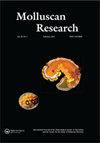Seasonal changes in fatty acid profile of the freshwater snail Viviparus contectus (Millet, 1813) from lake habitat
IF 0.8
4区 生物学
Q3 ZOOLOGY
引用次数: 0
Abstract
ABSTRACT The freshwater snail, Viviparus contectus, is an important shellfish owing to its nutritional composition (i.e., high amounts of protein, essential amino acids, fatty acid profile and minerals) and its promise as a candidate for the treatment of some diseases in traditional medicine. Hence, the seasonal changes in the fatty acid (FA) profile of Viviparus contectus caught from Demirköprü Dam Lake were determined in this study. Saturated fatty acid (SFAs) (64.54–80.39% of total fatty acids) had the highest concentration followed by polyunsaturated fatty acids (PUFAs) (10.63–21.83%) and monounsaturated fatty acids (MUFAs) (6.57–10.13%). Stearic acid (C18:0) was the major SFA while arachidonic acid (C20:4 n−6) was the major PUFA. The season significantly affected the FA profile of V. contectus while no significant difference was determined between seasons with respect to tissue MUFAs levels. A higher level of total SFAs was detected during spring (80.39%) while a higher proportion of MUFAs was detected during the winter (10.13%). The total amounts of PUFAs were highest in winter (21.83%). Overall, V. contectus has nutritional value. However, V. contectus caught in autumn may be nutritionally the most valuable for human consumption due to higher eicosapentaenoic acid 20:5 n−3 and docosahexaenoic acid contents.湖泊栖息地淡水蜗牛Viviparus contractus(Millet,1813)脂肪酸剖面的季节变化
本文章由计算机程序翻译,如有差异,请以英文原文为准。
求助全文
约1分钟内获得全文
求助全文
来源期刊

Molluscan Research
生物-动物学
CiteScore
1.80
自引率
10.00%
发文量
27
审稿时长
>12 weeks
期刊介绍:
Molluscan Research is an international journal for the publication of authoritative papers and review articles on all aspects of molluscan research, including biology, systematics, morphology, physiology, ecology, conservation, biogeography, genetics, molecular biology and palaeontology.
While the scope of the journal is worldwide, there is emphasis on studies relating to Australasia and the Indo-west Pacific, including East and South East Asia. The journal’s scope includes revisionary papers, monographs, reviews, theoretical papers and briefer communications. Monographic studies of up to 73 printed pages may also be considered.
The journal has been published since 1957 (as the Journal of the Malacological Society of Australia until 1993). It is free to members of the Malacological Society of Australasia and the Society for the Study of Molluscan Diversity.
 求助内容:
求助内容: 应助结果提醒方式:
应助结果提醒方式:


